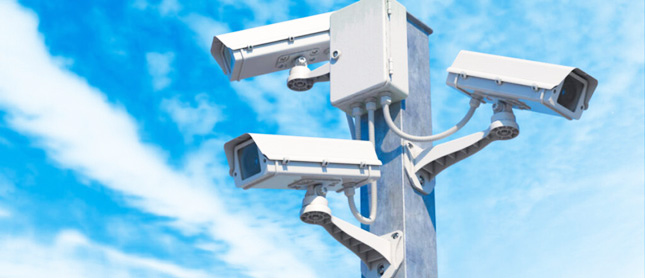
Prakash Prabhu – Chief Business Officer & Co-Founder, VisionBot
In an ever-evolving world with new security challenges emerging regularly, the need for innovative and advanced security equipment has never been greater. As we step into 2023, the security industry continues to push the boundaries of technology to enhance safety measures. In this blog, we’ll explore the latest advances in security equipment technology for 2023, covering everything from surveillance cameras and access control systems to biometrics and AI-powered analytics

The Evolving Landscape of Security
Security concerns have expanded beyond traditional physical threats to include cyberattacks, public health emergencies, and the need for contactless solutions. To address these challenges, security equipment manufacturers are constantly innovating.
Here are some of the latest advancements shaping the security landscape in 2023:
- Artificial Intelligence (AI) and Machine Learning: AI and machine learning are transforming security by enabling intelligent analysis of vast amounts of data in real-time. AI-powered analytics can detect anomalies, recognize faces, and identify suspicious behavior, making security systems more proactive and effective.
- Integration and Interoperability: Security equipment is becoming more interconnected, allowing different systems to work together seamlessly. Integrated solutions enable a holistic approach to security, where information from various sources such as cameras, sensors, and access control systems, is consolidated for a more comprehensive view.
- Contactless Access Control: The COVID-19 pandemic accelerated the adoption of contactless technologies for access control. Solutions like facial recognition, mobile credentials, and touchless biometric systems are gaining traction to minimize physical contact and enhance security.
- Enhanced Biometrics: Biometric authentication methods are becoming more sophisticated and accurate. Advancements in facial recognition, fingerprint scanning, and iris recognition are making access control systems more secure and user-friendly.
- IoT and Sensors: The Internet of Things (IoT) has enabled the deployment of a wide range of sensors that can monitor environmental conditions, detect intrusions, and track assets. These sensors provide valuable data for security analysis and decision-making.
- Cloud-Based Solutions: Cloud-based security systems offer scalability, flexibility, and remote management capabilities. They are particularly attractive for businesses with multiple locations and a need for centralized control.
- Video Analytics: Video analytics technology is becoming more sophisticated. It can analyze video feeds in real-time to detect specific events or objects such as unauthorized access, suspicious packages, or loitering, improving overall security awareness. Now, let’s delve into specific areas of security equipment technology and explore the latest innovations in each category.
Surveillance Cameras: More Than Meets the Eye
Surveillance cameras have come a long way from their analog predecessors. The latest innovations in surveillance camera technology are focused on improving image quality, reducing false alarms, and enhancing analytics capabilities.
- 4K and 8K Resolution Cameras: High-resolution cameras with 4K and even 8K capabilities offer superior image clarity, enabling users to zoom in on details without losing image quality. This is particularly valuable in applications where visual evidence is crucial.
- Thermal Imaging Cameras: Thermal cameras can detect heat signatures, allowing them to capture images in complete darkness and adverse weather conditions. These cameras are valuable for perimeter security and search-and-rescue operations.
- 360-Degree and Panoramic Cameras: 360-degree and panoramic cameras provide a complete view of an area without blind spots. These cameras are ideal for large spaces like warehouses and parking lots.
- Advanced Analytics: Surveillance cameras are equipped with AI-driven analytics that can recognize objects, detect motion patterns, and send alerts for specific events. This reduces false alarms and enhances security response.
- Facial Recognition: Facial recognition technology has become more accurate and reliable, making it a valuable tool for access control and identification. Privacy concerns are being addressed with stricter regulations and ethical considerations.
Access Control: Beyond the Keycard
Access control systems are evolving to provide more secure and convenient ways of managing who can enter a facility or access sensitive areas.
- Mobile Credentials: Mobile apps can turn smartphones into access control credentials, allowing users to unlock doors with their devices. This technology is convenient and enhances security by enabling remote access management.
- Touchless Biometrics: Biometric access control methods, such as facial recognition and iris scanning, eliminate the need for physical contact with devices, reducing the risk of germ transmission.
- Behavioral Biometrics: Some access control systems use behavioral biometrics, such as keystroke dynamics and gait analysis, to verify users’ identities based on their unique behaviors.
- Two-Factor Authentication (2FA): To enhance security, access control systems increasingly incorporate 2FA, requiring users to provide two different types of authentication such as a fingerprint and a PIN code.
- AI-Powered Access Policies: AI algorithms can analyze access patterns and automatically adjust security policies based on user behavior, helping to detect anomalies and prevent unauthorized access.
Intrusion Detection: Keeping Unauthorized Parties Out
Intrusion detection systems are becoming smarter and more capable of identifying threats and vulnerabilities.
- Smart Sensors and IoT Integration: A coordinated security response is enabled by real-time communication between intrusion detection sensors and other devices.
- AI for Anomaly Detection: AI-driven algorithms can analyze sensor data and identify abnormal patterns, raising alerts for potential intrusions or breaches.
- Drones for Surveillance: Some security systems incorporate drones equipped with cameras and sensors to provide real-time aerial surveillance, especially useful for large outdoor areas.
- Acoustic and Vibration Sensors: These sensors can detect subtle sounds or vibrations associated with unauthorized access attempts, even in challenging environments.
Cybersecurity: Protecting Digital Assets
As the world becomes increasingly digital, cybersecurity is a paramount concern. Innovations in this field aim to safeguard data and networks from cyber threats.
- Zero Trust Architecture: Zero Trust security assumes that no one, whether inside or outside the organization, can be trusted. It requires strict authentication and authorization for all users and devices trying to access resources.
- AI-Enhanced Threat Detection: AI and machine learning are used to analyze network traffic and detect abnormal behavior indicative of cyber threats. These systems can respond quickly to potential breaches.
- Blockchain for Security: Blockchain technology is being explored for its potential in enhancing the security of data storage and transactions by providing immutable records and decentralized control.
- Quantum-Safe Encryption: As quantum computing poses a potential threat to current encryption methods, quantum-safe encryption algorithms are being developed to protect data from future quantum attacks.
Emergency Management: Preparing for the Unexpected
Innovations in emergency management technologies are helping organizations prepare for and respond to crises more effectively.
- IoT-Enabled Sensors: IoT sensors can monitor environmental conditions, detect fires, and provide real-time data to emergency response teams.
- Mass Notification Systems: Advanced mass notification systems can send alerts through multiple channels, including SMS, email, social media, and public address systems.
- Crisis Management Software: These platforms enable organizations to create and execute emergency response plans, ensuring a coordinated and efficient response to crises.
- Predictive Analytics: Predictive analytics can forecast potential crises by analyzing historical data, helping organizations proactively address risks.
Conclusion
The security equipment technology landscape is evolving rapidly to address new and evolving threats. From advanced surveillance cameras and access control systems to cybersecurity innovations and emergency management technologies, the security industry is leveraging the power of AI, IoT, and other cutting-edge technologies to enhance safety and protection in 2023 and beyond.
Staying informed about these innovations and incorporating them into your security strategy can help you adapt to the ever-changing security landscape and better safeguard your assets, whether they are physical, digital, or human. It is also important to note that as security challenges continue to evolve, technology designed to address them will also evolve, ensuring that safety and protection remain at the forefront of our priorities.
*Views expressed in the article are solely of the Author
![]()